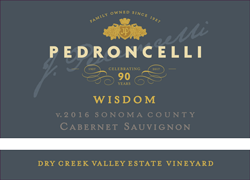Cabernet Sauvignon
-
A Legacy Continues!
September 24, 2024 09:43

Part of the excitement of being a small family winery is I get to work with winemaker Montse Reece to develop new wines to add to our portfolio. She knows the vineyards well, this is her 18th harvest at Pedroncelli! These are small lot of single vineyard estate wines (blocks really) that are deemed exceptional in quality. In the coming months, we are introducing four new wines.
2022 Legacy Block Home Ranch Vineyard Zinfandel
The inaugural release of our Legacy Block Zinfandel is a celebration of the grape here at Pedroncelli. Our house is founded on this versatile grape and we now have four prime examples of what we and Dry Creek Valley can produce—stellar Zins!
Zinfandel has been planted on the property since 1904. The founders Giovanni & Giulia Pedroncelli purchased a shuttered winery, a home, and 25 acres of mostly Zinfandel in 1927. A second generation was planted on the property in the early 1980s. The Legacy Block was the third generation and was planted in 2016.
When Vineyard Manager Lance Blakeley was choosing the clone to plant on the 3 acres of hillside, he chose the Rockpile Clone which was developed to the north of us and proven to produce high quality fruit on steep hillsides. It also sets a smaller more manageable crop so the fruit ripens evenly. This is important because Zinfandel is a famous uneven ripener.
Once the vineyard began to produce fruit it caught winemaker Montse Reece’s eye. She noticed that it showed a different side of the Zinfandel grape-one she had not detected in our other Zinfandels. She described the aromas as distinctive with wild berries, licorice, pomegranate and baking spices.
The yeast she chose to ferment this Zinfandel was also derived from the Rockpile area and she feels complements the grapes while they ferment, bringing out the best in the fruit and adding complexity to the wine. The Legacy Zin is a very aromatic lighter-style zin. Montse uses American oak from Missouri with a lighter toast showcasing the fruit better without overpowering the wine.
The legacy indeed continues as we sourced the fruit from the our latest replanting of Zinfandel.
-
Ped 101
May 31, 2022 14:49
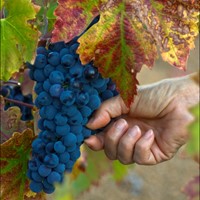
It is nice to have a long weekend every once in a while to reflect and take time out from busy schedules. Lately we have all been working at what feels like breakneck speed here at the winery as we build out our 10 year plan following strategy assessments and portfolio planning. And as we head into the 95th anniversary of our family business I would like to take a look back as well as forward.
Our tale begins when a young family was looking around for some property in 1927 with a GI Loan to back them up and some cash in hand to fund the purchase. A property was found near the town of Geyserville with vineyard, a shuttered winery (thanks to Prohibition) and a home. 90 acres of land located in Dry Creek. The American Viticultural Appellation ‘Dry Creek Valley’ didn’t come along until 1983. It must have been quite a move for the family to go from Dunsmuir California to Geyserville with no connections. The link to this new community was the vineyard. They could still sell the grapes to home winemakers which helped both the family and the vineyard to thrive and survive. Their ‘social’ network established them with other families and our story began.
Intertwined with our family history is Zinfandel. First planted on the property in the early 1900s it was the grape which became the foundation of our portfolio, and our flagship wine. What became known as the mother vineyard was replanted or cloned back into place becoming our Mother Clone. It continues today as the mainstay in our line of wines.
Another part of our story is told through Sonoma Classico, our red wine blend. My grandparents were new to winemaking when Repeal came around allowing them to now make wine commercially. They made wines from what was grown on the estate-Zinfandel, Petite Sirah, Carignane and maybe a little Golden Chasselas and Burger thrown in for good measure. It didn’t come with a varietal name as it was a field blend. Today this wine evokes those early years with the focus on estate fruit and is a classic on its’ own.
The next chapter continues with Cabernet Sauvignon. Second generation brothers Jim and John purchased property on West Dry Creek Road in 1965 and, based on market observations of what people wanted to drink, they planted this grape, the first winery in the valley to do so. Today we are on the second generation of vineyard there and now farm a total of 33 acres on the estate. Our Three Vineyards Cabernet is singular and reflective of the soil and climate. This wine deserves the designation of our second flagship.
Weaving white grapes into the mix, we have planted a few of them over the years. The early days we had Golden Chasselas and Burger, later French Colombard and Sauvignon Vert. These made way for Gewurztraminer and Riesling along with a bit of Chardonnay. They all had their time to shine depending on the era and we found Sauvignon Blanc, planted in the early 1990s, takes the prize as the longest planted. It is the grape which captures best the microclimate of Dry Creek Valley and reflects this in the wine itself. And having grown up 'Dry Creek' this is indeed a grape that deserves all the attention.
As we look to the future as a family some things will change and others stay the same-it is the age old story. We are building a strong base, as strong as the first generation and following generations. I look forward to sharing our journey with you. -
An Early Finish for Harvest 2021
September 28, 2021 08:12
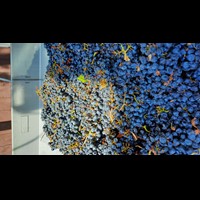
The hardworking vineyard and cellar crew have completed vintage 2021 in what has to be one of the fastest harvests in our 94 years here. What began on August 25 ended on September 23, 30 days! It brought to mind previous vintages and was very reminiscent of 2014 (September 24) and 2015 (September 23) which were also drought influenced years at Pedroncelli.
The overview of the harvest this year starts with the growing season which was in the normal range without too much heat or other challenges along the way. The lack of water for a second year impacted the vineyards and the results are a bit lower in production in varieties overall. During harvest Mother Nature stayed even for the most part, just a few days in the high 90s, which of course sped things along as the vineyard blocks ripened and the grapes were ready to pick and waiting for their tank space in the cellar.
Winemaker Montse Reece gave a few of her comments on the vintage:
“This harvest is a pleasant surprise. We had good weather so far with just a few hot days but not as intense as in past harvests. The grapes matured at their own pace without rushing. Each of the grape varieties came in on their usual timing once harvest began, just a more compressed cycle as compared to other vintage years.
Because it’s a drought year our yields are down between 20-30% depending on the varieties. Berries are also smaller so volumes are lower. Because of the smaller yields and berries, we are having high concentration of phenols. The aromatics this year are fantastic, I‘m very much looking forward to tasting the final wines from this vintage.”
The winemaking team creates the tagline for the harvest shirts each year. For 2021 it was Pronti? Via! (Ready? Let’s Go!). To give you an inside look at what goes on during harvest I had Marcus Cano do a short video on a recent harvest day. You'll see many familiar faces including winemaker Montse Reece, cellarmaster Polo Cano, Vineyard Foreman Manuel Diaz with his crew along with Mitch Blakeley, Vineyard Assistant, talking us through the process.
For now fermentations will continue over the next couple of weeks and, once finished, the new wines will take their place in the cellar until aging in barrels or bottling in the case of the Sauvignon Blanc and Rosé. I’ll finish by tweaking the phrase slightly by saying Pronti? Beviamo! (Ready? Let’s drink!).The final load of grapes for vintage 2021 was from our Block 007 estate Cabernet Sauvignon.
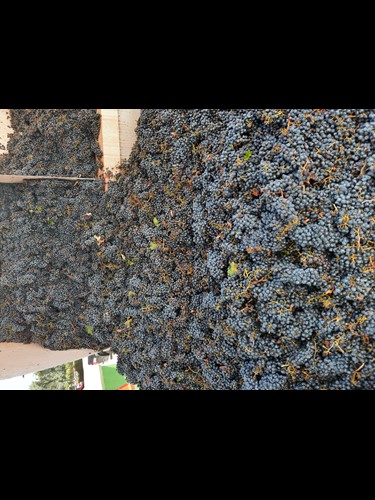
-
Vintage Notes
March 30, 2021 16:22
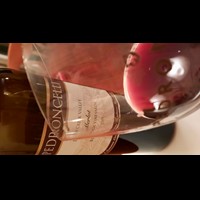
This is the first of a monthly blog post on wines from our cellar here at the winery. Ed, Colin and I have been taking apart stacks of wines in our warehouse and inventorying them. We of course need to taste them to make sure they are doing fine, drink now or forget about it.
It began last month with Open That Bottle Night but as we delved into the cases of wine stacked in and around the warehouse we realized doing some tasting notes on these gems would be a good thing to have here on Vino in my Dino.
2009 Merlot
Cork Finish
This was a nice surprise. The very mellow wine with touches of red brick around the edges of the glass. Softened by age this Merlot still has the stuffing to age another year or two. The beauty of this gem is it is ready to drink now should you have some in your cellar-a few more years will be okay as well.
2002 Alexander Valley Cabernet Sauvignon
Cork Finish
From the Morris Fay vineyard this is a wine that has aged quite well. Notes of tobacco, leather and a nice fruit core of cherry on the aromatics as well as flavor. A long finish is framed by softening, but not too soft, tannins signaling this wine will age well for a few more years.
2001 Block 007 Cabernet Sauvignon
This is the first year we made a small lot wine from this block. And I am here to tell you this has aged beautifully. Notes of dried herbs linger on the nose along with touches of plum and black pepper spice.
2016 Signature Selection Chardonnay
Screw Cap
Not much color change-a deepening gold perhaps from the pale yellow of first release. Still lively with mellowed aromatics of melon and apple. Acidity is still bright, the flavors are rich and the finish is heightened by the perfect balance of fruit and acidity.
-
Follow the Vineyard: Harvest Ends
September 28, 2020 16:06
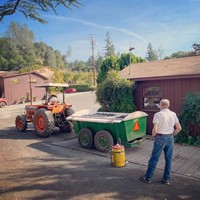
Vintage 2020 was one of the fastest harvests in our 93 years at Pedroncelli. It began on August 24 with Sauvignon Blanc and ended with our Cabernet Sauvignon on September 23. And this vintage year began with the pandemic and ended amidst it with all the accompanying safety guidelines in placed. A fire to the west of us complicated things with a brief evacuation followed by smoke high above the valley from the large Walbridge fire. Add a couple of high heat weeks and the grapes ripened along quickly. Reminiscent of the 2017 vintage which was equally as fast.
We follow the vineyard with Mitch Blakeley, fourth generation family member, who works with his dad Lance and is our Vineyard Manager and a key part of the winemaking team which also included Montse Reece and Polo Cano. He gave me an update on the grapes, the vineyards and the vintage:
"Just as we are picking the last load of Cabernet Sauvignon we are also back out in the vineyard preparing for winter by planting cover crop and fertilizing the vines. We are heading into a heat wave next week and we are buttoning things up so the vines can get some much needed rest.
The harvest overall was very quick and busy in that we picked every day between August 24 and September 23 except for two of the days. We don’t pick on Sundays as well and this gives everyone a break to get ready for another busy week-rest, make plans, gear up.
I find this year similar to 2017 in that we had high heat over Labor Day weekend then and this year as well. The crop is also lighter and similar to three years ago. I learned more this year than I knew when I worked the 2017 harvest, that’s for sure. To give an example at how quickly the fruit ripened I’ll use our Zinfandel as an example. At the beginning of Labor Day weekend the fruit samples came back at 24 brix-we watched the brix (sugar) rise a degree per day and by Monday we had 27 degrees Brix-and we picked it as fast as we could to preserve the style we like in our Zins.
Aside from all the challenges we were on par for a great vintage. We’ll now play the patience game and wait for the overworked labs to get us results to see if there is any smoke damage in the new wines.
A couple of other notes; we machine harvest about 15% of our vineyard: Sauvignon Blanc and Cabernet Sauvignon blocks that are cane pruned and able to withstand the machine taking fruit off. You need to have some age on the wood so it doesn’t break off and damage the vine. Another anomaly this year was the amount of labor we had-his dad Lance noted it was like 30 years ago when labor was plentiful. The reason this year is because other wineries delayed picking or cancelled picking of vineyards and we had people eager to work."
Thanks Mitch for the update as we follow the vineyard through 2020.
-
Note from Home: We Are Farmers After All
August 31, 2020 16:08
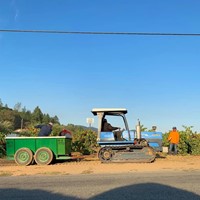
This is our 93rd harvest at Pedroncelli Winery. The last five months are marked with head-shaking challenges including COVID, sheltering in place, and now fires. We have seen a lot in these last nine decades. No one, including my 88-year-old father Jim, has seen anything like this. The kicker? The vines are doing their thing just like any other vintage and surviving the slings and arrows of Mother Nature. We are farmers after all, and harvest isn’t going to wait.
The vineyards marched toward the day of harvest from the very start of this pandemic. Some of those slings and arrows in the past included rain or heat, too much fruit ready to be picked and not enough space, an early harvest or one that seemed to stretch on forever. We came out of July ready to harvest after Labor Day weekend-marking this as a cooler growing season. The change came when the weather warmed up and sped ripening. Regarding vineyards and warm weather, I learned some great information from our vineyard manager Lance Blakeley a couple of years ago. “Vines are like people” he said, “and they actually shield the fruit by slightly moving the leaves into a protective position, providing much needed shade from the sweltering heat.” Kind of like using an umbrella to shade us on the beach-we’ll survive with some shade and relief from the sun.
So the results are in--we are picking on Monday August 24! Things are moving ahead quickly as the development in the vineyard leaves no doubt the grapes are ready to pick. Samples have been taken, analysis performed and the first grapes to pick are, drumroll please, our Sauvignon Blanc. Looking at past harvest dates this is right on par with the two previous years, not too early and not too late. We had large production in the 2018/2019 vintages, so this year is looking a little lighter in comparison but overall, about average. Of course, there are other extenuating circumstances: the virus, labor shortage, the COVID rules of keeping everyone safe and healthy which will also take away some of the time spent picking grapes so progress will be a bit slower. Harvest will go on however even under these adjustments.
Then there are the fires. Thunder and lightning came to our area (which reminded people of the weather you usually see in other parts of the U.S). Started by lightning strikes earlier this week the fires are active all over northern California as far south as Monterey County to northern Sonoma County. The Wallbridge/Skaggs Fire is about 4 miles away from the winery behind the ridge line above the valley floor. Dry Creek Valley covers a huge area with just a part of it planted to 9000 acres of vineyards. The bulk of the land to the west is forested and largely uninhabited. Through the powerful images seen on television, in newspapers and social media many of you have seen the results of the fires here in the state and valley. Like the other fire years of 2017 and 2019 we are not in the midst of them but are associated with them and so far are safe. We are keeping all of our neighbors, friends, family and staff in mind hoping all remain out of harm's way as well.
We are farmers and join the legions of other farmers across this land as we watch and wait for the weather, the challenges, the preparation and finally the harvest. Like the generations before, we must have patience, fortitude and hope. I have no doubt whatsoever that the harvest of 2020 will go down in history as one of the most challenging and exceptional vintage stories ever. -
Why Cabernet Sauvignon?
August 7, 2020 14:55
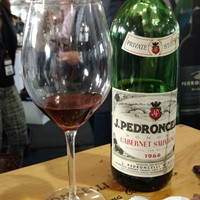
Earlier this year I chose Cabernet Sauvignon as the varietal of the year and have posted a few thoughts on them (here). Yes it is the king of red wine grapes worldwide, it is made in almost every region and its’ distinctive traits come from the personality of the site: climate, soil, how it is planted, clonal selection. What makes this of all the red wines the ‘one to plant’?
In 1965 John and Jim Pedroncelli bought 5 acres of land just off of the corner of West Dry Creek Road and Yoakim Bridge Road. It was planted to prunes at the time-no old vine story here. Jim and John had purchased the winery from their parents in 1963 so I consider this their first venture following the ownership change. The varietal they chose? Cabernet Sauvignon. Up until now we had the acreage planted on the Home Ranch (Zinfandel, Petite Sirah, Pinot Noir!, Chenin Blanc) and this was a momentous decision-it meant we were adding a wine that would one day become equal to production of our Zinfandel, and the now the most widely planted red wine grape in California.
Why did they plant this particular variety? There weren’t many vineyards along the valley floor at the time or anywhere for that matter-the area was just on the brink of a wine Renaissance in the 1970s. Like this land most of the valley floor had been turned over to prune and other orchards when Prohibition set in and the thriving vineyards were pulled up and other crops were set in their place. It was time to reclaim the soil for wine grapes!
Why Cabernet Sauvignon? Let’s look at how wine reentered the scene first of all. Following Prohibition, the Great Depression and World War II, which were all challenges to what was once a burgeoning wine industry in the area, we needed people to re-engage with wine. One of the outcomes of this war, which sent troops abroad, was the experience tasting European wines. They came back with a thirst for wines similar to what they had tasted there and Cabernet was among those.
In the first years of production, while waiting on the estate vineyard to mature and produce, John and Jim bought from Alexander Valley grape growers Robert Young and Harry Wetzel, both of whom had started growing Cabernet a few years earlier. Sometimes there was even a bit of Zinfandel blended in by John to stretch the production in those early vintages. Our first release of Cabernet Sauvignon was in 1966.
Today the entire production comes from estate vineyards which encompasses 32 acres-our Three Vineyards, Block 007 and Wisdom. The great growing conditions of northern Dry Creek Valley, with the right climate and gravelly soils, gave us the ability to grow and make great Cabernet. We replanted that first vineyard on West Dry Creek Road around 2005-it was 40 years old. Trying to maintain an old Cabernet vineyard was becoming far too difficult. I previously mentioned clonal selection and when the new vineyard was planted, now named Wisdom, John chose the Mendoza clone or Clone 4 to plant there. Four vintages of Wisdom prove he was right in selecting it-and this wine is the expression of the wisdom gained by planting one variety of grape in one place and showcases the distinctive fruit of this clone. The torch is now carried forward by winemaker Montse Reece who honors the memory of John with each vintage produced.
Time to time I have been fortunate to taste the wines from those early years. I also have received notes from friends who have pulled a bottle from their library and truly enjoyed the wine, sending glowing reports and photos-each one a time capsule of its own. They continue to tell the story of my family farming the king of red wine grapes for 55 years.
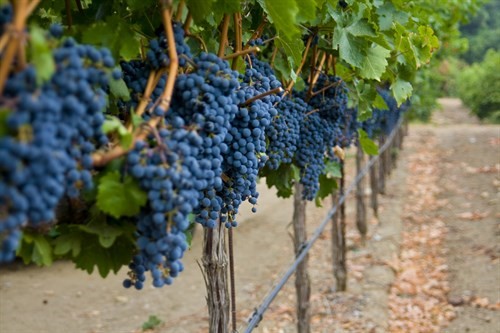
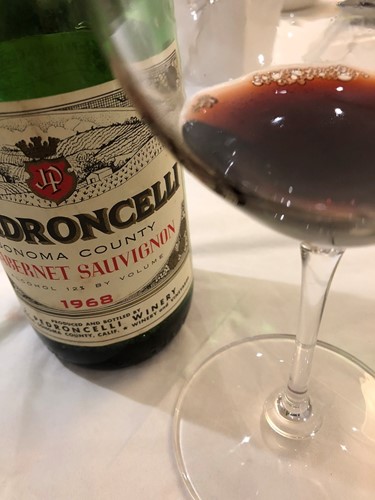
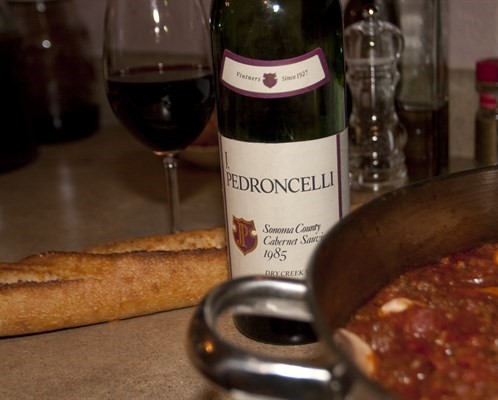
-
Follow the Vineyard: Veraison
July 24, 2020 15:50
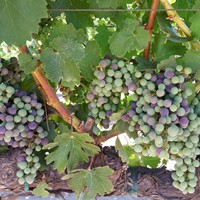
Another month into vintage 2020 and the next stage of the grape development is here: veraison. From here on out we can predict harvest dates by when the fruit begins the transition from hard green pea sized berries to a lighter softer green in the white varieties and shades of purple in the reds. I caught up with Mitch Blakely, fourth generation family member, as he was heading home for the day.
“We are watching the vines as the crop on each turns color-all but 11 acres of what we farm are red wine varieties and Merlot seems to be out ahead of the pack at 50% of the fruit turning color. Zinfandel isn’t too far behind at about 35%. Other varietals like Sauvignon Blanc, Sangiovese and Cabernet Sauvignon range from 5-15%. What that tells us is we’re looking at an average to slightly later harvest with mid-September for white grapes and lighter red wine grapes followed by Cabernet Sauvignon and Petite Sirah the first couple of weeks of October. This timing is typical of the past harvests from normal growing seasons. And of course this will change if the weather spikes higher as we get nearer to picking.”
“It’s been hot at the beginning of July so one of the other jobs I had was trying to find blocks needing water. The vines were getting slightly stressed, slowly development down because of heat although some of the days topped out at 100 degrees but tapered off as the late afternoon fog began to come in. While fairly early on in the season it is better to have the higher heat at this time. Varietals susceptible to damage during heat are Zinfandel, Merlot and Sangiovese on hillside or limited soils where they have a tough time bouncing back. Cabernet Sauvignon and Sauvignon Blanc, on the other hand, can handle it. It was unseasonably cool at the last half of July which helped the vines out a lot."
He continued, "The crop size is fairly consistent, not as big of a year as last year. Not as many clusters and counts are down-which is a good thing because it is easier on the vines. We'll see COVID harvest protocols slow down harvesting with smaller crews and split crews for picking in order to keep our vineyard crew safe. Hoping for a nice even harvest with lots of time in between. Other projects include working on the vine blocks under the Scott Henry system where they are separating out the canes and pinching them down so the arms aren't snapped off during machine harvesting (Cabernet Sauvignon and Sauvignon Blanc). There are 20-25 acres of the split system so it takes a while-7 acres done so far and there is time to get this done. Pulling leaves and dropping fruit (also known as green harvest) also has taken place in order to allow ripening of the clusters as well as lightening the load on the vine."
Thanks Mitch for the time and information-cheers to Vintage 2020 as it comes more into focus with each month. Follow our vineyard next month when we are in striking distance of harvest.
-
Follow the Vineyard: Bloom
May 21, 2020 08:24
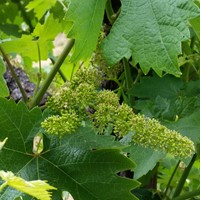
Following the progress at our estate vineyards helps keep things in perspective. While we all shelter in place (hopefully not for much longer) the vines are happily making their way toward vintage 2020. I visited with Mitch Blakeley, fourth generation family member, to check in and get his perspective about what it going on out in the vineyard.
We farm 115 acres of vineyard between the Mother Clone, Home Ranch, Three Vineyards, Wisdom, Alto Vineyards, Bench Vineyards, East Side Vineyards and Bushnell Vineyard with 11 varietals planted between all of them. Some of these are small blocks while other encompass 30 or so acres between them. It all adds up to quite a bit of work for Lance Blakeley, Vineyard Manager, and Manuel Diaz, Vineyard Foreman along with Mitch who is not only in the vineyard he also led the certification process for sustainability in both the vineyard and winery.
Here are some in depth details about what is going on right now as we follow the vineyard this month in the bloom phase. Bloom or flowering (I’ll use the terms interchangeably) takes place about 6 weeks after budbreak, the first growth in the vine since winter dormancy which typically takes place in March. The leaves and shoots lengthen during the next month or so and small ‘bunches’ form. Bloom is when the future bunch of grapes breaks into tiny flowers-the smell is heavenly!-with crop set following in the next few weeks.
Follow the vineyard as I recap Mitch's comments on what is going on this month: The rain, while not as heavy compared to 2019’s six inches, actually mirrors almost to the day the time it rained the third week of May in last year. Over a week or so about an inch and a half of rain fell this year. What did this do to the vines? While April was warm and a few days in early May were over 90 degrees it became cold and rainy, slowing bloom time down. One of the benefits of receiving rains in the spring: it saves water. Mitch predicted they would be able to skip a full cycle of operating the drip irrigation system in the vineyards. Vines rely on interspersed drip irrigation during the dry months of summer and late rain helps delay the initial cycle of watering.
Flowering in some of the varietals, like Cabernet Franc, went quickly and is almost complete. Slow bloomers like Sauvignon Blanc and Cabernet Sauvignon were just beginning. Zinfandel was at about 40% and other grapes like Sangiovese and Petite Sirah were somewhere in between. Rain will sometimes knock off some of the flowering which in turn might lower the production of fruit. It remains to be seen if this has happened in our vineyards-crop set takes place in June so we will know more by the end of next month.
The vineyard crew continues with tractor work, weed maintenance and suckering, which is the most important during this time because a vine will push lots of growth in the spring. If not taken care of by stripping off the multiple offshoots this will overburden the vine and eventually would inhibit getting a ripe crop if allowed to continue. Suckering takes place over the whole vine along the arms and at the base. Some of the wood is softer in varietals like Merlot and Sauvignon Blanc-so they will be suckered next but right now the crew is working on the Zinfandel and Cabernet as the vine trunks and arms are harder wood and harder to sucker as things begin to dry out. We are expecting 90 degree weather the last week of May and this accelerates the conditions so the crew is busy now in these vineyards in order to get ahead.
Thanks Mitch for the update. We've farmed for four generations and have seen many different scenarios throughout those years. This vintage will go in the books as one of the most unusual because of COVID19. As farmers we look forward to the next phase of growth because the vineyard naturally follows the tilt of the sun, the ebb and flow of weather and creates something new each year.
-
Varietal of the Year: King Cabernet Sauvignon
April 9, 2020 10:06
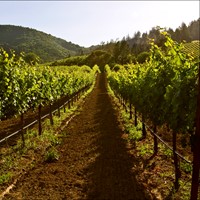
I am focusing on our other flagship wine this year: Cabernet Sauvignon. Did you know it is the most widely planted wine grape in California? Here are my thoughts on what makes this varietal special, thriving here in Dry Creek Valley Sonoma County.
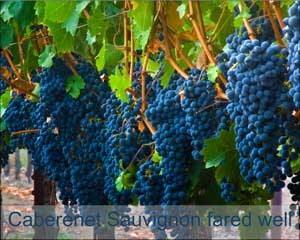 First up, the stats: Cabernet Sauvignon is king of wine grape acreage in California with 93,241 (bearing and non-bearing) total acres. It bested its’ rival Chardonnay by 93 acres. By comparison, about five years ago, there were 6000 more acres of Chardonnay than Cabernet Sauvignon-just in case you are keeping score. In Sonoma County (12,090 acres) it is the second most widely planted, with Pinot Noir almost equal and both bested by Chardonnay as the number one most planted grape. Dry Creek Valley, where Cabernet rises to the top winning the title of ‘most widely planted’ with 3200 acres, reigns as #1.
First up, the stats: Cabernet Sauvignon is king of wine grape acreage in California with 93,241 (bearing and non-bearing) total acres. It bested its’ rival Chardonnay by 93 acres. By comparison, about five years ago, there were 6000 more acres of Chardonnay than Cabernet Sauvignon-just in case you are keeping score. In Sonoma County (12,090 acres) it is the second most widely planted, with Pinot Noir almost equal and both bested by Chardonnay as the number one most planted grape. Dry Creek Valley, where Cabernet rises to the top winning the title of ‘most widely planted’ with 3200 acres, reigns as #1.Now for a bit of Dry Creek Valley wine grape history. The first grapes were planted, Zinfandel among them, in the mid-1800s with wineries following in 1872. The area burgeoned with production right up until Prohibition ended commercial winemaking in 1919. During this dry time many of the vineyards were pulled out by grape growers in order to make a living and were replaced by fruit trees and other crops (this area was known as the buckle on the Prune Belt for this very reason). Once Repeal made it legal to make wine again it took some time to get back into the business of developing a market, planting vineyards, and took a World War to engage the nation’s palate again. While my grandfather already had zinfandel and petite sirah on the home ranch he dabbled in planting Riesling and Pinot Noir among others.
It wasn’t until sons John and Jim bought five acres on West Dry Creek Road in 1965 that they became the first growers in the valley to plant Cabernet Sauvignon. They saw an appreciation for this varietal from those who served overseas and had become acquainted with the wines of France and Italy. Now they wanted to give customers a wine they appreciated. This vineyard would become known as our Wisdom vineyard. Beginning with this vineyard we learned over the next 5 decades what it takes to get the best out of this grape. We now farm 31 acres along the bench and valley floor. If there is a site specific grape I believe this is it.
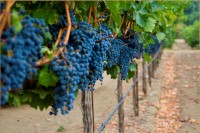
What makes Cabernet Sauvignon distinctive from our vineyard and valley? The location for one. Our estate vineyards are located in the northern end of the valley. Wisdom is on the valley floor on the ‘dry’ western side of the valley and our Three Vineyards and Block 007 are on an eastern bench across the way where the soils are gravelly loam with great drainage. Another distinction is in the trellising. Finding the right vine systems to maintain production and canopy are important because the vigor of the vineyard can get in the way of ripening. Canopy and crop management become key to a wine with a quality fruit profile. Cabernet Sauvignon needs sun to ripen and a long growing season. Dry Creek Valley’s climate is here to help with its’ ideal number of warm degree days paired with the all-important marine layer, cooling down the grapes at night. Both are the foundation of fruit development maintaining aromatics, acidity and balance. Hallmarks of our Cabernet Sauvignon show flavors of plum and berry fruit combined with tobacco or sage notes (Winemaker Montse Reece describes this as ‘greenier’) and wrapped in a firm core of tannin or 'grip' as John Pedroncelli would call it.
The combination of site specific planting, aspects of climate and soil, picking at the right moment after the desired hang time-Cabernet is usually one of the last grapes harvested-and, once at the winery, the choices of oak and aging give you a Cabernet Sauvignon you can enjoy upon release or has the staying power for the cellar. Either way it is fitting to consider the wisdom gained over 55 years of farming the king of red wine grapes.
Categories
- COVID
- Follow the Vineyard
- Note from Home
- PairItWithPed
- Pandemic
- pedroncelli
- Port
- Postcards from Home
- Pruning
- Seasons in The Cellar
- Tasting Room
- Thanksgiving
- Vintage Notes
- Winemaking
- Women's History Month
Recent posts
-
91 Years Later
-
Come Over October: It's About Community
-
Come Over October
-
A Legacy Continues!
-
Everything Old is New Again
Popular tags
- Block 007 Cabernet Sauvignon
- Bushnell Vineyard
- Mother Clone
- Heat wave
- Schotzki
- Easter
- Four Grapes Port
- French Oak
- Dry Creek Valley
- Cookies
- Barrels
- Cellar Master
- note from home
- Anniversary
- OpenThatBottleNight
- Oak
- Cabernet Sauvignon
- Finding Your Roots
- Pedroncelli
- PairitwithPed
- COVID Coffee Chat
- food and wine
- Habit
- Seasons in The Cellar
- Rosé
- COVID19
- family
- cooking with wine
- 1974 Cabernet Sauvignon
- Homecooking
- Pruning
- Sauvignon Blanc
- Reserve
- Recipes
- Crop set
- Holding steady
- Courage Zinfandel
- Harvest 2022
- Down to Earth
- Pantry
- Follow the Vineyard
- American Oak
- Sonoma County
- cheese
- newsletter
- Merlot
- Pandemic
- Estate Vineyard
- Library Wine
- Lake Sonoma



